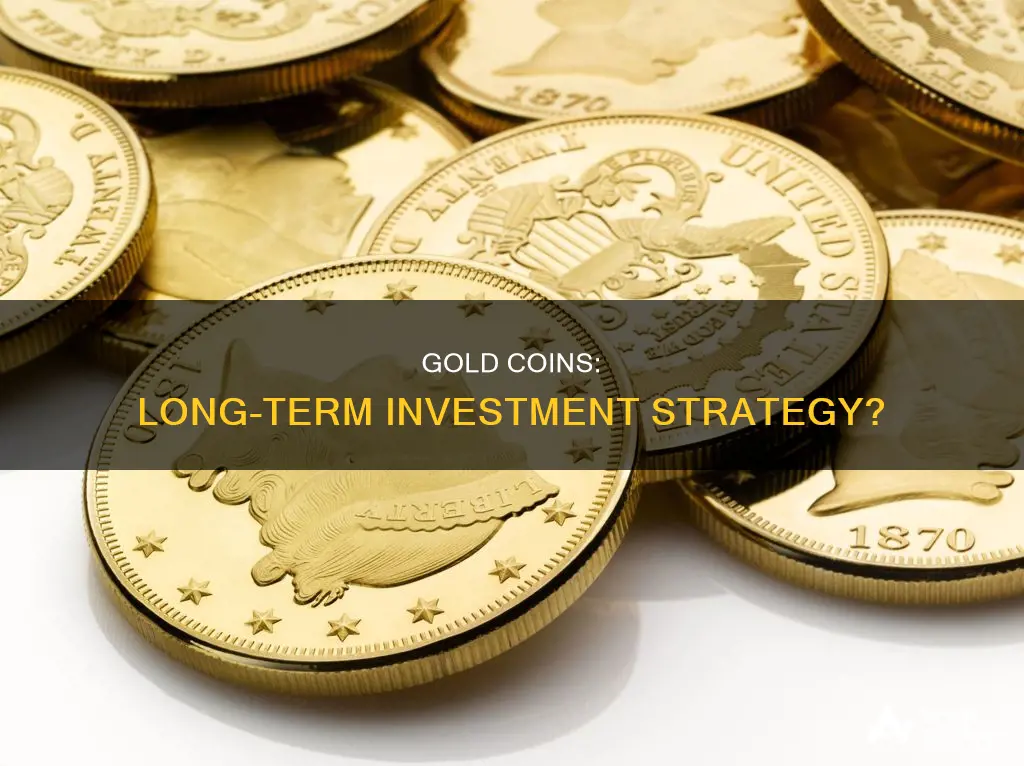
Gold has been a valuable commodity for thousands of years, but is it a good long-term investment? Gold is often viewed as an alternative investment to stocks, providing stability when stocks are volatile or declining in value. It is also considered a safe haven during market volatility and an investment that offers protection against inflation.
Gold has a negative correlation with stocks and other financial instruments, making it a good portfolio diversifier. It is also a physical asset that can be held directly as coins, bullion, or jewellery, or indirectly via mutual funds, exchange-traded funds (ETFs), gold derivatives, or gold-mining stocks.
However, gold has its drawbacks as a long-term investment. It does not generate income through dividends, and its price can be highly volatile. Additionally, there are costs associated with storing and insuring physical gold.
So, while gold can be a prudent choice for those seeking to diversify their portfolios and hedge against inflation, it may not be suitable for those looking for high returns or short-term investments.
| Characteristics | Values |
|---|---|
| Safe investment | Yes, gold is a safe investment during market volatility |
| Risky investment | Yes, gold is a risky investment as its price does not always go up |
| Income-generating asset | No, gold is generally not an income-generating asset |
| Investment costs | Yes, gold has storage and insurance costs |
| Long-term investment | Yes, gold is a good long-term investment |
| Volatile | Yes, gold is highly volatile |
| Inflation hedge | Yes, gold is a hedge against inflation |
| Diversified portfolio | Yes, gold works best as part of a diversified portfolio |
| Short-term investment | No, gold is not a good short-term investment |
What You'll Learn

Gold as a hedge against inflation
Gold is widely viewed as a hedge against inflation. It is often seen as a safe-haven asset when the economy turns sour, and the prices of stocks and bonds decline. It is also a store of value through market ups and downs.
Gold is priced in US dollars globally. When investors realise their money is losing value, they start positioning their investments in a hard asset that has traditionally maintained its value. For example, in the first half of 2022, demand for gold increased by 12% year on year, while consumer prices rose by 9.1% over the same period.
Gold also benefits from a declining US dollar. This is because those buying gold must sell their US dollars to make the transaction, driving the dollar lower. A weaker dollar also makes gold cheaper for investors holding other currencies.
However, gold has a mixed record as a hedge against inflation. While it performed well during the high inflation of the 1970s, it has underperformed during more recent periods of high inflation. From 1980 to 1984, for instance, annual inflation averaged 6.5%, but gold prices fell by 10% on average each year.
Gold has also been outperformed by stocks over the long term. From 1990 to 2020, the price of gold increased by around 360%. Over the same period, the Dow Jones Industrial Average (DJIA) gained 991%.
Gold is a physical asset and, therefore, requires storage and insurance. It can also be highly volatile and is not an income-generating asset. As such, gold works best as part of a diversified portfolio.
Mobile Finance Apps: Invest in Bitcoin Easily
You may want to see also

Gold as a safe haven investment
Gold is a safe-haven investment during market volatility and an investment that offers protection against inflation. When the stock market declines, the demand for gold increases, raising its prices. This inverse effect makes gold a good hedge against a falling stock market.
Gold is both a currency and a commodity, but it comes with risks, including price fluctuations. Gold is not an income-generating asset, and it does not pay dividends. Its return is based on price appreciation.
Gold has been a store of value for thousands of years. It is accessible and liquid, and it is easy to buy and sell. Gold is also a good portfolio diversifier as it has a low correlation with other asset classes like stocks and real estate. Its price moves independently of stock prices, so it can be a safe haven in uncertain political and economic times.
Gold is also a good hedge against inflation. As the cost of living increases, the price of gold tends to rise. Gold is seen as a good store of value, so people may be encouraged to buy it when they believe their local currency is losing value.
Gold is a safe-haven investment, but it is important to remember that it can be highly volatile and drop in price. It is best used as part of a diversified portfolio.
NRI Mutual Fund Investment: Can NRIs Use Coin?
You may want to see also

Gold as a long-term investment strategy
Gold is a unique asset that has maintained its value throughout the ages. It is considered a safe investment, acting as a hedge against market volatility and offering protection against inflation. However, gold can also be a risky investment as its price can be highly volatile and it does not always appreciate over time. Here are some key considerations for investing in gold as a long-term strategy:
Advantages of Investing in Gold:
- Gold is a safe-haven asset during market downturns and economic uncertainty. Its price often moves inversely to stocks and real estate, making it a good diversifier for an investment portfolio.
- Gold maintains its intrinsic value over time and is accessible and liquid, making it easy to buy and sell.
- Gold is a store of value and can help preserve wealth during periods of high inflation.
- Gold has a history of holding its value and is respected worldwide for its rich history and unique properties.
- Gold is a tangible asset that can be physically held and stored, which appeals to investors who prefer physical metals over paper assets.
Disadvantages of Investing in Gold:
- Gold does not generate income like stocks or bonds, so it may not be ideal for short-term investing.
- Gold is subject to price volatility and can experience significant fluctuations over time.
- Investing in physical gold incurs additional costs for storage, insurance, and maintenance, which can eat into potential profits.
- Gold may underperform other assets, such as stocks and bonds, over the long term in terms of price appreciation.
- Gold investments can be complex, and it is important to understand the risks, cash flow, taxes, and other considerations before investing.
Ways to Invest in Gold:
- Purchasing physical gold, such as bullion, bars, coins, or jewelry.
- Buying stocks of gold mining companies or exchange-traded funds (ETFs) that invest in gold.
- Investing in gold mutual funds or gold-related stocks.
- Gold futures, options, and derivatives.
- Gold Individual Retirement Accounts (IRAs) offer tax advantages and allow for investing in physical gold or gold-related assets.
Factors to Consider:
- Gold should be part of a diversified portfolio and should not dominate an investment portfolio. Financial advisors generally recommend allocating no more than 5-15% of your portfolio to gold or precious metals.
- Gold's performance is influenced by various factors, including the strength of the U.S. dollar, inflation, deflation, geopolitical tensions, and supply and demand dynamics.
- Gold prices tend to rise during periods of economic uncertainty, high inflation, and a weak U.S. dollar.
- Gold is not a foolproof investment, and its price can fluctuate significantly over time. It is important to consider your financial goals, risk tolerance, and investment time horizon before investing.
Easy Ways to Earn 1 Bitcoin Daily Without Investment
You may want to see also

Gold's performance over time
From 1990 to 2020, gold prices increased by around 360%, while the Dow Jones Industrial Average (DJIA) gained 991%. However, during the 15-year period from 2005 to 2020, gold prices increased by 330%, compared to a 164% increase in the DJIA. This shows that gold can sometimes outperform stocks over shorter time horizons.
Gold reached an all-time high of nearly $2,089 per ounce in August 2020 during the COVID-19 pandemic and spiked again above $2,000 per ounce during the Russia-Ukraine conflict in early 2022. As of March 2024, gold surpassed its 2020 high. Gold's performance during these periods of economic uncertainty demonstrates its potential as a safe haven investment.
Over longer periods, stocks and bonds have generally outperformed gold. For example, from 1971 to 2022, the DJIA appreciated by around 3874% while gold prices increased by approximately 5,700%. Gold's average annual returns from 1971 to 2019 were 10.6%, compared to 11.3% for global stocks.
Gold's performance relative to other assets depends on various economic factors and market conditions. Gold tends to rise during periods of high inflation, geopolitical uncertainty, and when the stock market is underperforming. However, gold can be volatile and may not always provide positive returns, especially during strong bull markets for stocks.
The Next Big Investment: Beyond Bitcoin
You may want to see also

Gold's role in diversifying investment portfolios
Gold is a unique asset class that can benefit an investment portfolio in several ways.
Firstly, gold is a hedge against inflation as it has historically maintained its value during periods of rising prices. Its value tends to increase as the purchasing power of fiat currencies declines. This makes gold a good investment during times of economic uncertainty and geopolitical turmoil.
Secondly, gold has a low correlation with other asset classes like stocks and bonds. This means that its price movements are generally not linked to those of other assets, which can help further diversify your portfolio and reduce overall risk.
Thirdly, gold is often seen as a safe-haven investment during economic downturns. Its demand and value increase as investors flock to gold in such situations. Gold is also a good currency hedge for investors holding assets in other currencies since it is priced in US dollars.
There are several ways to incorporate gold into your investment strategy, each with its own pros and cons. These include investing in physical gold (such as bars, coins, or jewellery), gold exchange-traded funds (ETFs), gold mining stocks, and gold mutual funds or index funds.
While gold can be a valuable addition to a portfolio, it is important to remember that it may not always generate positive returns. Gold does not generate income and can be highly volatile. Therefore, it is crucial to carefully consider the various gold investment methods and choose an approach that aligns with your investment objectives, risk tolerance, and preferences.
Investing in Bitcoin: Is It Worth Putting $1000 in Crypto?
You may want to see also
Frequently asked questions
Gold is considered a safe investment and a hedge against inflation. It is also a good way to diversify your portfolio. However, gold does not generate income and is subject to price volatility.
The worldwide average annual return of gold between 1971 and 2022 was 7.78%, but there can be significant fluctuations from year to year.
There are several ways to invest in gold, including purchasing physical gold such as bullion, coins, or jewellery, or buying stocks of gold companies or funds.
Gold is a hedge against inflation and economic uncertainty, and it can help diversify an investment portfolio. Gold also maintains its value over time and can be physically held.
Gold does not generate income, so it may not be suitable for short-term investing. It is also subject to price volatility and can be complex to buy and store.







